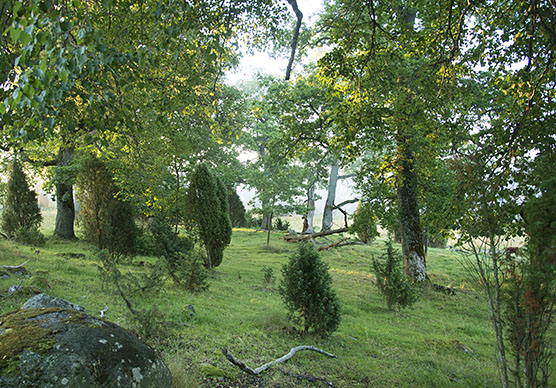Press release 2018-12-18 at 8:57
The threat status of habitat types in Finland was evaluated for the second time. Almost half (48%) of the nearly 400 habitat types across the country were assessed to be threatened. In southern Finland, the proportion of threatened habitats is clearly higher (59%) than in northern Finland (32%). The status of habitat types has not improved during the past decade; instead, the trend among many habitat types is assessed to be declining. However, it is possible to improve the status of habitats.

Semi-natural grassland meadow in Parainen. Photo Riku Lumiaro.
57 habitat types were classified as Critically Endangered (CR). Out of these, as many as 40 were semi-natural biotopes, i.e., grasslands, meadows, pastures and grazed woodlands. Other habitats classified as Critically Endangered include river habitats in clay soil areas in southern Finland, rich fens, and snowbeds in fell areas threatened by climate change. The highest numbers of Endangered (EN) and Vulnerable (VU) habitat types were found in groups of mires, forests and coastal habitat types by the Baltic Sea.
Semi-natural grasslands are the most threatened, while rocky and fell habitat types are better preserved
All semi-natural grasslands and grazed woodlands were assessed to be threatened, with a majority of them assessed as Critically Endangered. Forest habitat types have the second largest share (76%) of threatened habitats, while the lowest shares are found in inland waters (20%), the Baltic Sea (24%) and rocky habitats (25%). The small percentages in the Baltic Sea and inland waters can partly be explained by the poor knowledge of the status of these habitats. It should also be noted that the percentages of threatened habitat types do not only reflect the recent pace of decline, rather, the results may also have been affected by historical decline. When the quantity and quality of habitat types were compared to the pre-industrial era, the threat status was increased in nearly a quarter of all habitat types, although recent decline in those habitats may not have been as strong.
The highest numbers of non-threatened habitat types (categories Near Threatened or Least Concern) were found among the rocky and fell habitats. For example, acidic rock outcrops and scree, as well as some of the oligotrophic mire habitats found predominantly in northern Finland are assessed to be of Least Concern. Habitats in the category Least Concern also include habitat types that have increased in area in recent decades and show no significant deterioration, such as coastal reedbeds with Phragmites australis and coastal Salix spp. thickets.
Habitat types face many threats but there are ways to improve their status
The most important reasons for habitat types being threatened were forestry, drainage, clearing of areas for arable land, construction, and eutrophication. Among the reasons in the past, climate change was considered to have little impact (with the exception of the fell area) but it is estimated to gain considerable significance as a threat factor in the future.
Decisions on how to apply the results of this assessment will be made later, following a broad-based preparatory work. In order to facilitate this preparatory work, the expert teams have proposed 70 measures in total for improving the status of the threatened habitat types. The key is in paying more attention to threatened habitat types in land use planning and the use of natural resources.

The division of habitat types into Red List Categories in each habitat type group according to the number of habitat types. The number of habitat types in each group is shown on the right. The Red List categories: LC = Least Concern, NT = Near Threatened, VU = Vulnerable, EN = Endangered, CR = Critically Endangered, and DD = Data Deficient. Habitat types classified as VU, EN and CR are threatened.
The protection, management and restoration of habitats must be made more efficient and we must find new methods, such as ecological compensation. Climate change increases further the need to launch and find new, efficient measures to improve the status of threatened habitat types as it intensifies the negative impact of many threats, such as eutrophication.
Finland at the forefront of assessing habitat types
A new international method, the IUCN Red List of Ecosystems, was used in the assessment. Finland is pioneering the use of this method. The method provides detailed criteria for evaluating the changes in the quantity and quality of habitat types, and their rarity. Evaluation was performed on all main groups of habitat types: the Baltic Sea, its coast, inland waters and shores, mires, forests, rocky habitats, semi-natural grasslands and grazed woodlands, and fell habitats. Changes were examined during the past 50 years and over a longer time span with a comparison to the pre-industrial era of the 1750s. Attempts were also made to predict future changes. In addition, current trends for each habitat type were assessed to be improving, stable, or deteriorating.
Due to a change in method, the results of the first and the second threat assessment are not directly comparable, but the results indicate the cases where genuine change in threat is seen from the previous evaluation. Genuine change was only observed in 22 habitat types, and in almost all cases, the change meant moving to a higher threat category. Evaluations of the current trends of habitat types also indicate a primarily downward direction: in the whole country, the trend for 57% of habitat types was estimated to be deteriorating, while the percentage for an improving trend was 5.
The threat assessment of habitat types was performed in an extensive three-year project involving more than 120 experts from various research institutions, universities and agencies. The work was coordinated by the Finnish Environment Institute (SYKE), and participants include all national key actors, such as Natural Resources Institute Finland (Luke), several universities, the Metsähallitus Parks and Wildlife Finland, the Geological Survey of Finland, Finnish Museum of Natural History, Centres for Economic Development, Transport and the Environment, the Government of Åland, the Finnish Forest Centre and the Reindeer Herders’ Association. The work was steered and funded by the Ministry of the Environment and a steering group set by the Ministry and made up of all the key bodies that generate information on natural habitats.
Appendices
Assessment results by habitat type groups
For further information, please contact
Head of Unit Anne Raunio, Finnish Environment Institute (SYKE), tel. +358 295 251 547, firstname.lastname@ymparisto.fi
Senior Research Scientist Tytti Kontula, Finnish Environment Institute (SYKE), tel. +358 (0)400 148 680, firstname.lastname@ymparisto.fi
Environment Counsellor Aulikki Alanen, Ministry of the Environment, tel. +358 (0)40 684 7146, firstname.lastname@ym.fi
Biodiversity & Communication Expert Riku Lumiaro, Finnish Environment Institute, tel. +358 (0)40 509 8654, firstname.lastname@ymparisto.fi
Press photos located on the Finnish language Press release